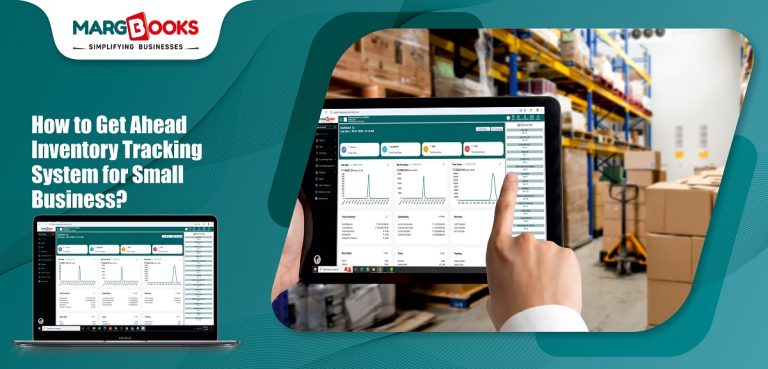Running a small business is no small feat, especially when it comes to managing inventory. With fluctuating demand, various suppliers, and the need for constant stock updates, an efficient system is essential to keep things running smoothly. The key to this success lies in an inventory tracking system for small businesses.
In this blog post, we’ll explore how you can use an inventory tracking system to streamline your operations, reduce waste, and save time. We’ll also discuss the integration of inventory software with your existing accounting software to ensure smooth, error-free financial management. If you’re new to this, don’t worry! We’ll guide you through the entire process and introduce Margbooks as an effective tool to help you achieve your business goals.
Why is Inventory Tracking So Important for Small Businesses?
Before we dive into the specifics of setting up an inventory tracking system, it’s important to understand why inventory management is crucial for your small business.
- Avoid Stockouts and Overstocks: Without a proper tracking system, you risk either running out of stock, which results in missed sales, or overstocking, which ties up valuable capital.
- Cost Efficiency: An effective inventory system helps minimize storage costs, reduces waste, and ensures that you are only ordering what’s needed, when it’s needed.
- Better Decision-Making: With real-time insights into your stock levels, you can make smarter purchasing and sales decisions.
- Improved Customer Satisfaction: Accurate inventory ensures that customers get their orders on time, enhancing their experience and loyalty.
How Can an Inventory Tracking System Benefit Your Small Business?
Adopting an inventory tracking system for small businesses brings numerous benefits that can help grow your business and improve operational efficiency:
- Real-Time Updates: With automated tracking, you can get live updates of your stock levels, enabling quick decisions on restocking and avoiding delays.
- Increased Accuracy: Say goodbye to manual tracking and the errors that come with it. Automated systems ensure the accuracy of your stock records.
- Data Insights: A good inventory tracking system will generate reports, helping you identify trends and optimize your inventory levels. This insight can guide business strategies from pricing to promotions.
- Integration with Accounting Software: Modern inventory systems can easily integrate with accounting software, allowing you to sync inventory data with financial records for seamless bookkeeping.
Key Features to Look for in an Inventory Tracking System for Small Business
When searching for an inventory tracking system for small businesses, you should look for these essential features:
1. Barcode Scanning Capabilities
Barcode scanning helps streamline the tracking process, ensuring that inventory updates are quick, efficient, and error-free. With barcode scanning, stock updates happen automatically, reducing human error and improving overall efficiency.
2. Real-Time Tracking
Inventory levels should be tracked in real time to prevent discrepancies between what’s on hand and what’s recorded in your system. This also allows you to detect discrepancies and address them immediately.
3. Automatic Stock Alerts
A good inventory system should notify you when stock is running low, giving you enough time to reorder. This helps prevent stockouts, which can impact sales and customer satisfaction.
4. Multi-Channel Support
If your small business sells products across multiple platforms—whether through a physical store, an online store, or marketplaces like Amazon—your inventory system should integrate with all these channels to keep your stock levels accurate and up-to-date across the board.
5. Easy Integration with Accounting Software
The ability to sync your inventory system with accounting software is crucial for small businesses. It ensures that your stock purchases and sales are automatically recorded in your financial system, reducing manual entry errors and keeping your accounts in sync.
6. Reporting and Analytics
The ability to generate detailed reports on your inventory, sales, and purchase trends can help you optimize your business operations. Analytics will help you make informed decisions about restocking, sales strategies, and more.
How Margbooks Can Help You with Inventory Tracking?
Margbooks is a user-friendly and efficient solution for small businesses looking to streamline their inventory management. It offers an integrated inventory software and accounting software solution, providing everything you need in one package. Here’s how Margbooks stands out:
1. Seamless Inventory Management
Margbooks makes it easy to track your inventory in real time. Whether you have one location or multiple, you can manage stock efficiently, ensuring you always know your inventory levels. Automatic updates and stock alerts help you avoid overselling or running out of stock.
2. Easy Integration with Accounting
With Margbooks, your inventory management is integrated directly into your accounting software. This seamless integration ensures that purchases, sales, and stock adjustments are reflected in your financial records automatically, reducing the need for manual input and improving accuracy.
3. Detailed Reporting and Insights
Margbooks offers advanced reporting features, providing insights into your sales trends, stock movement, and more. These reports can be customized to meet your specific needs, helping you make data-driven decisions that propel your business forward.
4. Multi-Channel Support
If you’re operating across different platforms, Margbooks supports integration with online sales channels, allowing you to track inventory across both physical and online stores. This multi-channel capability ensures that your stock records are accurate and up-to-date at all times.
5. User-Friendly Interface
Margbooks is designed to be easy to use, even for those with limited technical expertise. Its intuitive interface makes managing inventory and finances simple, so you can focus more on growing your business.
How to Implement an Inventory Tracking System for Your Small Business?
Now that you know why an inventory tracking system is important, let’s walk through the steps to implement it in your small business:
Step 1: Choose the Right Software
Start by selecting the right inventory software for your business. Consider the features that are most important to you, such as barcode scanning, reporting capabilities, and integration with accounting software.
Step 2: Set Up Your Inventory System
Once you’ve chosen your software, you’ll need to input your existing inventory data into the system. This may involve entering stock levels, product details, and supplier information.
Step 3: Train Your Team
Make sure your team is trained on how to use the system. Proper training will help ensure that everyone is on the same page and can use the system effectively to manage inventory.
Step 4: Integrate with Accounting Software
If your inventory system allows integration with accounting software, set this up to automatically sync your inventory data with your financial records. This will save you time and reduce the chances of errors.
Step 5: Monitor and Adjust
Once your system is in place, monitor it regularly to ensure it’s working as expected. Use the reports and insights generated by the system to make adjustments as needed.
Conclusion
In today’s competitive business landscape, staying ahead requires smart technology. An inventory tracking system for a small business is an investment that can help you reduce errors, save time, and increase profits. By integrating an effective inventory software solution with your accounting software, you can keep your business running efficiently and focus on what matters most—growth.
Margbooks provides an all-in-one solution that’s both powerful and easy to use, making it an excellent choice for small businesses looking to take control of their inventory and accounting needs. Whether you’re just starting or looking to upgrade your current system, investing in the right tools today can give you the competitive edge you need to succeed tomorrow.




